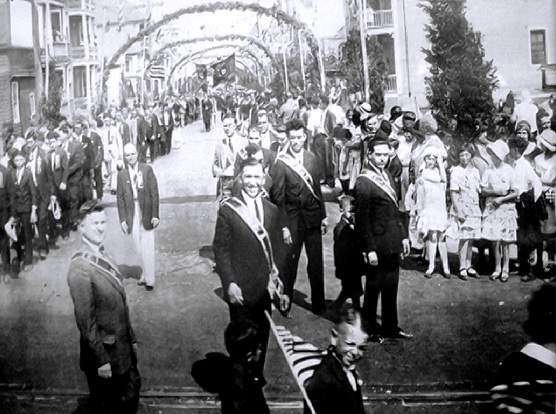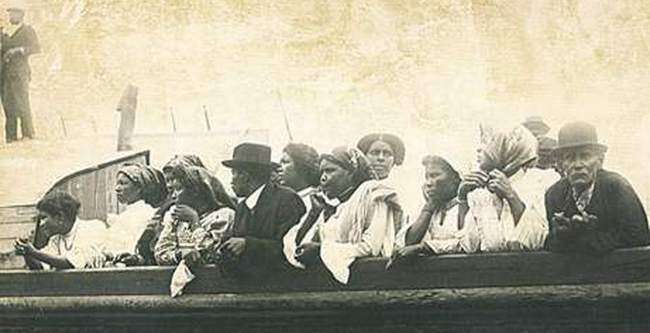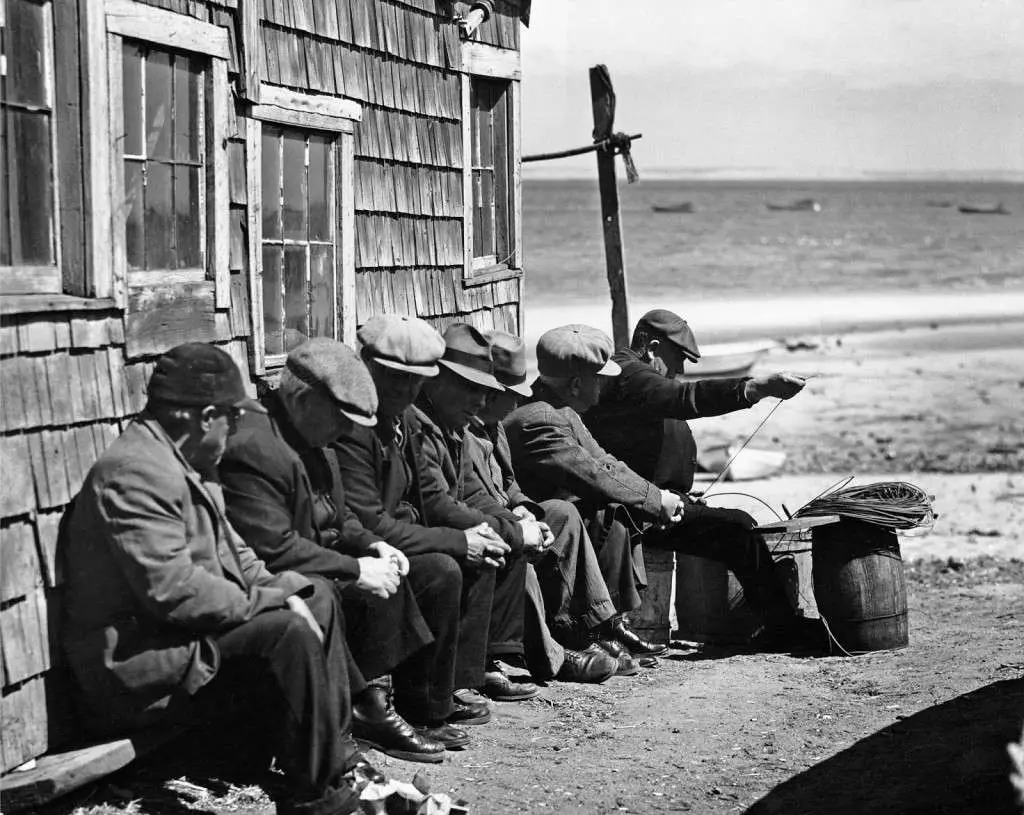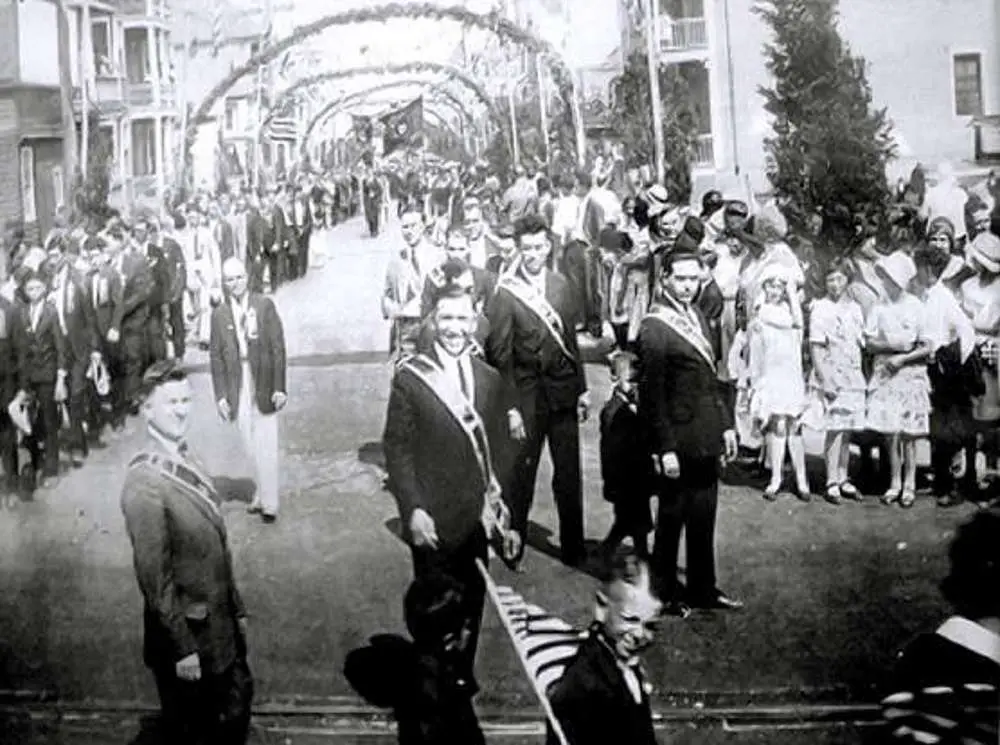In 1915, four Madeiran men organized a feast at the Church of the Immaculate Conception in New Bedford, Mass. They did it to celebrate the safe arrival of Portuguese immigrants after a stormy journey.
The festival mimicked the traditional religious feast observed in their village on Madeira Island. It included a celebration of the Roman Catholic Mass, a grand procession, traditional food and folk dancing.

Portuguese immigrants celebrating the Feast of the Blessed Sacrament in the 1960s. Photo courtesy Museum of Madeiran History.
Today, the 104-year-old Feast of the Blessed Sacrament is the largest Portuguese festival in the world. It reflects both the size and the identity of the Portuguese-American population in New England.
Two great waves of Portuguese immigration gave Southeastern Massachusetts and Rhode Island the densest concentration of people with ancestry from Portugal, including the Azores and Cape Verde.
They made their mark with restaurants and bakeries, with fishing fleets, with Roman Catholic churches and with the Boston Red Sox. Dustin Pedroia, Jonny Gomes and Shane Victorino all have Portuguese ancestry. So do actor Tom Hanks, U.S. Sen. Jack Reed and Aerosmith’s Joe Perry.
Portugal also produced John Philip Sousa, who composed that most American march, Stars and Stripes Forever. And Emma Lazarus, who came from Portugal, wrote the inscription on the Statue of Liberty.
The First Portuguese Immigrants
The first Portuguese sailor, Miguel Corte-Real, may have come to Massachusetts as far back as the early 16th century. A 40-ton boulder now in Dighton Rock State Park is inscribed with writing that Brown professor Edmund B. Delabarre believed was written by Corte-Real.
In 1912, Delabarre wrote that the inscription on the Dighton Rock said, “I, Miguel Cortereal, 1511. In this place, by the will of God, I became a chief of the Indians.” (Well, maybe.)
During the Colonial period, a small number of Portuguese immigrants came to the islands of Martha’s Vineyard and Nantucket.
Jewish Portuguese immigrants came early to America to escape persecution. Wealthy merchant Aaron Lopez and his associates brought the sperm oil industry to Newport, R.I. They also built the Touro Synagogue in the 18th century .
Until about 1870, whaling drew Portuguese sailors from the Azores and the Cape Verde Islands. Poverty and military service sent them. They signed on for low-paying, dangerous work on whale ships. Then they settled in whaling communities in New England, California and Hawaii.
Easy To Get In
Portuguese families started to come to the United States in larger numbers around 1870 just as the whaling industry began to decline. They worked in New England’s booming textile mills, in whaling and fishing. And the women worked as seamstresses in garment shops.

In 1914, immigrants from Brava, Cape Verde, looking ashore from the Savoia as they await the disembarkation process to be finished. Photo courtesy New Bedford Standard-Times.
In the late 19th century, many Portuguese, mainly Azorean and Madeiran, settled in Providence, Bristol and Pawtucket in Rhode Island. They also settled in New Bedford, Taunton, Fall River, Gloucester and Provincetown in Massachusetts. And they moved to Hartford and New Haven in Connecticut.
“It was easy to get into this country in those early days,” wrote Portuguese immigrant Lawrence Oliver in his autobiography. “America was a free port. To get in, all you needed was a little money in your pocket, so that the authorities could be sure you wouldn’t be destitute and on relief right away.”

Portuguese dory fisherman gossiping in the sun, Provincetown 1942. Photo courtesy Library of Congress.
Opportunity
Even during the Great Depression, Portuguese immigrants found opportunity in America. As Capt. Joseph Captiva, a Provincetown fisherman, told a government interviewer in 1938,
…it’s a good place to live. Good money an’ chances for th’ young people. They say it’s bad times now, but we ain’ never seen bad times here like in ol’ country. (Read the whole interview here.)
The newcomers began to form fraternal benefit societies. They also printed their own newspapers, such as A civilizacao luso-americano in Boston. They maintained strong ties to the Roman Catholic Church, and formed committees of festeiros to stage the religious festivals that survive today. The religious festivals subsequently helped Portuguese immigrants retain their sense of community and identity.

Evening recreation of the “Young Holy Ghosters” – Ages 15–25, average is 18 – all mill workers – all Portuguese immigrants. Location: Fall River, Massachusetts. Photograph by Lewis Wickes Hine, 21 June 1916. Photo courtesy Library of Congress.
Throughout Massachusetts, Rhode Island and Connecticut, Portuguese-Americans hold religious festivals in the summer. They include the Feast of St. Anthony’s in Pawtucket, West Warwick and Portsmouth, R.I.
In Massachusetts, they celebrate the Festa do Divino Espirito Santo in East Taunton, The Feast of the Holy Ghost in Fall River and the Provincetown Portuguese Festival and Blessing of the Fleet.
In Connecticut, a Portuguese Day Festival is held every year in Danbury. Festa De Sao Joao is held in Waterbury. Portuguese-American residents of Stonington, Conn., also hold an annual Feast of the Holy Ghost.
Portuguese immigration peaked between 1910 and 1920, then slowed considerably. Literacy was low in Portugal, and many Portuguese immigrants couldn’t get in after the U.S. government instituted a literacy test in 1917. Then the government followed with a quota system that further reduced the numbers of Portuguese immigrants.
The 2nd Wave of Portuguese Immigrants
A series of volcanic eruptions in the Azores from 1957-58 spurred the second wave of Portuguese immigration to the United States. The Capelinhos volcano, on the coast of the Azorean island of Faial, erupted on Sept. 27, 1957. And it didn’t stop until Oct. 24, 1958.
No one was killed, but the volcanic activity covered the island with ash. It also destroyed homes and forced several thousand residents to leave. As a result, Congress in September 1958 passed the Azorean Refugee Act allowing 4,800 Azoreans to immigrate.
Then seven years later, the Immigration and Nationality Act of 1965 abolished the quota system, spurring a new wave of Portuguese immigration. Portuguese then began to enter the United States at the rate of 11,000 to 12,000 per year. Consequently, 44.5 percent of all Portuguese immigration to the United States took place between 1961 and 1990.
By the Numbers
People of Portuguese descent make up only four-tenths of one percent (0.4 percent) of the entire U.S. population. But in Rhode Island, they make up 9.7 percent of the population. As a result, that’s the densest concentration of Portuguese in the country.
Massachusetts has the second densest concentration of Portuguese-Americans, with 6.2 percent. Connecticut ranks fourth, with 1.3 percent, mostly concentrated in the Hartford-West Hartford-Willimantic area.
But the majority of Portuguese-Americans in New England cluster in Southeastern Massachusetts and Rhode Island.
Forty-one percent of East Providence residents claim Portuguese ancestry. So do at least one in five residents of Bristol, Warren and Tiverton.
Though Rhode Island has the densest Portuguese population, it only has the third largest. Massachusetts has more Portuguese residents with ancestry from Portugal than any other state in the country. About 320,000 now live in the Bay State, according to estimates of the 2010 Census. Fall River, Mass., has the densest concentration of Portuguese- Americans in the United States — 43.9 percent. And Portuguese Americans make up at least a third of the population of North and South Dartmouth, New Bedford, Dighton and Somerset.
California also has a large number of residents with ancestry from Portugal.
Madeira Wine
Hence the Feast of the Blessed Sacrament in early August attracts tens of thousands to New Bedford from nearby. They come for folk dancing, pop music, soccer and, most of all, traditional Madeiran food. They’ll feast on carne de espeto, bacalhau, linguica, ceviche, bifana sandwiches and milho frito. (For a description of these foods, click here.)
The beverage of choice? Madeira wine, of course.
The festival then ends with a parade. It follows a route marked by 70 arches of bayberry leaves, illuminated by twinkling lights.
The next festival will begin on Aug, 3, 2023.
You may also enjoy this story about how Portuguese farmers made Falmouth strawberries famous here. This story about Portuguese immigrants was updated in 2023.



28 comments
Very interesting! I’ve been curious about the long Portuguese settlement in the Americas.
Did the fascist government that controlled Portugal so long in the 20th century cause any refugee outflux to New England? It seems to have effected Cape Verde and Angola, though the violently racist policies enacted under Salazar et al targeted colonial residents of color.
Salazar was racist? I am a Portuguese with almost 60 years old who lived in Africa the first 21 years.
Yes, first of all Salazar was anti-communist. A crazy anto-comunist. Second Salazar was conservative, a very conservative leader. Third Salazar was very religious, a Catholic man.
He had the same stat car for 42 years!! When he died he had 12 shirts and 7 suits!
He invested in the African colonies a lot more than in the mother land (Portugal).
He understood the need of a higher level of culture for the African people in the Portuguese territories and in Mozambique, for example, in 1974 (the start of descolonization) Portugal had more primary schools in Mozambique than in the continental Portugal!
So, Salazar is a controversal figure, yes! He forbidden (with violence) some basic human rights (mainly the right to be a comunist or a liberal) but it was not eveithing bad….
The Africans HAD their own culture. Mozambique, Guinea-Bissau, Angola, Cape Verde were merely colonies. But lest we forget, there is also a BIG TIME African heritage in Portugal that antedates the Moors by millennia; the Portuguese carry African genes, both North of- and Sub-Saharan.
True. My 100% Portuguese dad is 6% North African.
BIG TIME African heritage? I wouldn’t quite say that.
Genetic studies of the Portuguese DNA have shown that the presence of E3b1 DNA, and Haplogroup L and U6 lineages (all common to North Africa) while present in Portugal, only make up for a very small percentage of the overall Portuguese genetic pool.
The entrance of this DNA is understood to come primarily from Prehistoric post-glacial migration from North Africa across the Straits of Gibraltar and to a lesser extent from the North African Berber and Arab settlers/occupiers who arrived during the Moorish invasion, and to a far lesser extent from African slaves brought to Portugal during the Atlantic Slave trade.
Here’s a more detailed picture:
Portuguese DNA includes a high frequency of the HLA-A25-B18-DR15 and A26-B38-DR13 genes. The later is a unique Portuguese marker- the Portuguese have neither a significant contribution to their genetic pool from paleo-North Africans (A30-B18) nor Mediterraneans (A33-B14). As such may have remained in relative genetic isolation compared to the rest of the Iberian populations. The A25-B18-DR15 gene is only found in Portugal among Europeans.
The pan-European (most probably Celtic) haplotype A1-B8-DR3 and the western-European haplotype A29-B44-DR7 are shared by Portuguese, Basques and Spaniards. The later is also common in Irish, southern English, and western French populations. R1b, is the most frequently occurring paternal lineage in Western Europe and occurs in extremely high rates in Portugal.
Not completely discounting what you stated, as depending on which region you’re from in Portugal, there are North African genes present within the Portuguese population, (just as there are in Spain, Italy, France, etc.) but to describe their occurrence in the way that you did would be very disingenuous.
You hit it right on the head. After having my DNA tested i find your writings describe my genes to a tee. Only a .12% African decent. Compared to 53% European,and 46% Iberian. With a little Italian,Irish,and Jewish mixed in.
[…] 1912, Edmund Burke Delabarre laid a new claim on the rock, arguing it was evidence of Portuguese discovery of America. The Brown University scholar summered near the rock for many years and had spent countless hours […]
Very interesting reading.I enjoy reading anything about our culture, and on what we have exeled. There must more people of Portuguese ancestry that have exeled. I know that there are some players current in the NHL, and some have retired.
[…] Provincetown was then a ramshackle village, a haven for Portuguese fishermen, sailors on benders, Bohemians from Greenwich Village and artists and intellectuals fleeing the war in Europe. It was a place where conventions were shed and parties got out of hand. […]
[…] food splashing about and the opener risking injury. This went on for 40 years. Enter Ezra Warner of Waterbury, Conn. Warner was already a successful businessman in 1858. He was a stockholder in the Waterbury Hook and […]
[…] After graduating from the Pennsylvania College of Arts, he and his father shared a studio in the Annisquam village of Gloucester, Mass. […]
Very interesting piece, thank you. I’ve learned more in the last 10 minutes about the Portuguese presence in Rhode Island than I did in four years at Brown University in Providence. (Granted, I probably could have sought out the information back in the day.) I hope today Brown makes more of an effort to provide students with R.I. history. The thought “required course” crosses my mind – fat chance of that Brown. I could imagine the school sponsoring a snappy and watchable 30 minute film about state history and devoting a room at the Rock to artifacts that change every month or so.
Brown U. has been offering excellent lusophone studies for quite some time (Dept. of Brazilian and Portuguese Studies). Check it out…. Happy Holidays! Boas Festas! Sempre p’ra frente!
Re:
A.
December 10, 2017 at 8:56 am:
Your comment is awaiting moderation.
PLEASE CHANGE:
“Dept. of Brazilian and Portuguese Studies” to read
“Dept. of Portuguese and Brazilian Studies.”
Thank you.
A.
HAPPY HOLIDAYS!!
When referencing the Portuguese in the United States you seem to conflate immigrant and ethnic in the population data you cite.
É bom lembrar os nossos imigrantes na América e que tanto sucesso tiveram na construção civil, ainda hoje.
Oral histories from the Little Compton, RI Azorean community reveal that teenage boys were abandoned by captains on the wharves in New Bedford and found crying by local farmers who took them home to work as farm laborers. Other Azorean boys were dropped offshore in the water, made their way to the closest house and pantomimed a request to work in exchange for food and shelter. They assimilated quickly and encouraged family members to join them. Today about 20% of the community has Azorean roots.
How interesting! Thank you for sharing!
I am second generation Portuguese. I really enjoyed reading this article. Thank you
[…] 1881, she befriended with Emma Lazarus, who wrote the poem at the base of the Statue of Liberty. Lazarus’ death from cancer at age 38 […]
[…] variations – Franco-Americans have their tourtiere, Italian-Americans have their ricotta pie and Portuguese-Americans have their custard tarts. Clam pie is stronger on Cape Cod than […]
[…] he got a bright idea: He would bring his students to Ellis Island to photograph the thousands of immigrants who arrived every day. Over five years he took more than 200 plates; but more importantly, he […]
[…] Portuguese settlers in Brazil then began making shoes, boots, hats and clothes from rubber. They set up camps in places where the trees grew abundantly and tapped them for the gum. Workers then took the fluid to the camp and smeared it over wooden models of the shoes or boots. The items were then held over a smoking fire until dry and cured in the sun. When ready, the shoes and boots were stuffed with dry grass and exported to Europe or America. […]
[…] it, was once a shabby old seaport that had fallen on hard times. Yankees lived on one side of town, Portuguese on the other. When the railroad came, it put the Portuguese on the wrong side of the […]
[…] Jones concluded something had exploded. He didn't believe, though, that he saw definitive evidence of a volcano. […]
[…] Island’s Portuguese people contributed chorizo or chourico (pronounced shuh-reese), a small, dense, spicy sausage to the […]
[…] Plus–I live in New England, and we have one of the biggest populations of Portuguese speakers in the worl…! Because I work with the public, I knew my Portuguese would come in handy all the time at work. […]
[…] […]
Comments are closed.